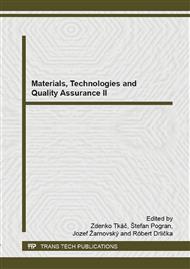[1]
M. Müller, Research of renovation possibility of machine tools damage by adhesive bonding technology, Manufacturing Technology, 13(4) (2013) 504–509.
DOI: 10.21062/ujep/x.2013/a/1213-2489/mt/13/4/504
Google Scholar
[2]
R. Mikuš, R. Drlička, V. Kročko, Riešenie utesňovania ježkovacích komôr plynovodov (Solving of cleaning chambers sealing of gas pipelines), Technická diagnostika, 14(2) (2005) 246–252.
Google Scholar
[3]
M. Müller, D. Herák, Dimensioning of the bonded lap joint, Research in Agricultural Engineering, 56(2) (2010) 59–68.
DOI: 10.17221/35/2009-rae
Google Scholar
[4]
R. Drlička, R. Mikuš, V. Kročko, Optimalizácia materiálu tesnenia veka ježkovacích komôr, in: J. Žarnovský et al. (Eds. ), Kvalita a spoľahlivosť strojov (Quality and reliability of machines), SUA in Nitra, Nitra, 2004, p.167–169.
Google Scholar
[5]
M. Müller, P. Valášek, Comparison of variables influence on adhesive bonds strength calculations, Manufacturing Technology, 13(2) (2013) 205–210.
DOI: 10.21062/ujep/x.2013/a/1213-2489/mt/13/2/205
Google Scholar
[6]
M. Müller, R. Chotěborský, P. Valášek, S. Hloch, Unusual possibility of wear resistance increase research in the sphere of soil cultivation, Tehnicki Vjesnik – Technical Gazette, 20(4) (2013) 641–646.
Google Scholar
[7]
W. R. Boughton, R. D. Mera, G. Hinopoulos, Environmental degradation of adhesive joints single-lap joint geometry, NPL Report CMMT(A) 196, Teddington, (1999).
Google Scholar
[8]
M. Müller, Influence of surface integrity on bonding process, Research in Agricultural Engineering, 57(4) (2011) 153–162.
Google Scholar
[9]
J. Józwik, I. Kuric, M. Sága, P. Lonkowic, Diagnostics of CNC machine tools in manufacturing process with laser interferometer technology, Manufacturing Technology, 14 (2014) 23–30.
DOI: 10.21062/ujep/x.2014/a/1213-2489/mt/14/1/23
Google Scholar
[10]
S. Legutko, G. Krolczyk, G. Krolczyk, Quality evaluation of surface layer in highly accurate manufacturing, Manufacturing Technology, 14 (2014) 50–56.
DOI: 10.21062/ujep/x.2014/a/1213-2489/mt/14/1/50
Google Scholar
[11]
M. Müller, D. Herák, P. Valášek, Degradation limits of bonding technology depending on destinations Europe, Indonesia, Tehnicki Vjesnik – Technical Gazette, 20(4) (2013) 571–575.
Google Scholar
[12]
M. Novák, Surface duality hardened steels after grinding, Manufacturing Technology, 11 (2011) 55–59.
DOI: 10.21062/ujep/x.2011/a/1213-2489/mt/11/1/55
Google Scholar
[13]
P. Valášek, J. Žarnovský, M. Müller, Thermoset composite on basis of recycled rubber, Advanced Materials Research, 801 (2013) 67–73.
DOI: 10.4028/www.scientific.net/amr.801.67
Google Scholar


